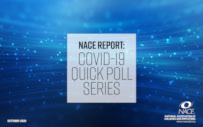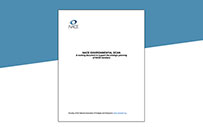
NACE is conducting a quick poll and would like your input to assess ways that campus recruiting may be impacted. Last spring, we saw increased campus protests and lockdowns in response to student activism. As we prepare for the fall semester and campus recruiting, there is a potential for increased campus unrest in response to global and national events (i.e. Presidential election, war in Middle East). This Quick Poll is intended to get an overall understanding of the ways university recruiters and campus career centers are preparing for possible campus unrest related to the recruiting process.

The conversion rate for interns fell, fueled by a lower offer rate. The lower rate could reflect lower-than-expected hiring needs or could signal an issue with the intern selection process.

Belonging at work—feeling that one is valued, accepted, and supported—helps to ensure a healthy, productive, and positive work environment. NACE surveyed its membership to better understand their experiences with belonging in the profession.

Employers were slower in making offers to their candidates for their full-time positions than they were prior to the pandemic, although students who accepted the offers were quicker to do so.

Despite calls to “return to the office” from employers and the prevailing media narrative, the hybrid work modality appears here to stay.

NACE President & CEO Shawn VanDerziel shares NACE research, which indicates that both employers and college students and graduates view higher education and the college degree as valuable.

Employers confirmed their belief in the value of higher education and higher education institutions in NACE’s latest benchmark survey.

As we enter the new school and recruiting season, NACE is conducting a Fall Quick Poll. The focus of our poll is on two important issues– the impact the end of Affirmative Action is having on our work and state of unpaid internships.

This is a Quick Poll on AI (ChatGPT, DALL-E 2, and Bing AI). NACE is interested to see if and how you are using AI, as well as your thoughts on the growth of AI in the future. This research will help us understand its use among members. The polls run May 2, 2023 through May 19, 2023, and results are offered in real time.

Slightly more than 85% of employers reported having formal diversity recruiting goals, according to NACE’s 2022 Recruiting Benchmarks Report, but how effective are these efforts?

The amount of time for students participating in a job interview to receiving an offer has increased over the past several years, but the time they take to accept the offer dropped in 2022.

Employers are strongly committed to in-person college recruiting activities this fall as they are largely unencumbered by travel restrictions that organizations imposed during the COVID-19 pandemic, according to results of NACE’s Quick Poll on Fall Recruiting and Career Services.

Based on their forward-looking staffing plans for the upcoming year, it appears employers are expecting similar or higher levels of recruiting activity this year, according to preliminary results of NACE’s Summer 2022 Quick Poll on Fall Recruiting and Career Services.

The percent of interviews resulting in a job offer has climbed to its highest level of the past five years, but acceptances and retention rates for the first three years of employment fell.

To facilitate planning and benchmarking for both employers and career centers, the National Association of Colleges and Employers (NACE) is conducting a quick poll that looks at fall recruiting as well as how career services offerings will be delivered.

Employers overwhelmingly believe hosting internships is the recruiting strategy that yields the highest return on investment leading to entry-level hires.

This is a quick poll on spring recruiting and career services. Specifically, we want to learn about the ways you are planning for internships and recruitment and ways that may have shifted over time, and insights you also learned from this fall. This research will help us all prepare for the new year. The polls run December 12, 2022 through January 15, 2023, and results are offered in real time.

The average number of full-time URR staff members that organizations employ decreased to 13.5 from 14.3 last year.

On average, there were 8.5 full-time recruiters per recruiting department within organizations replying to NACE’s 2021 Recruiting Benchmarks Survey.

Internships provide employers an opportunity to identify talent early: Indeed, according to NACE’s 2019 Recruiting Benchmark Survey Report, nearly all respondents (94 percent) said it was very or extremely important to identify talent early through internships.1

Interviews-per-hire average (IPHA) is the average number of interviews conducted with each college hire. IPHA is a deeper analysis to determine the variation of recruiting processes across positions or sourcing channels.

The applicant-to-hire ratio (AHR) is the average number of applicants for each college hire. AHR can be used to determine the relative interest for various jobs. In general, a higher AHR reflects the general interest in an organization’s opportunities; however, a low AHR may indicate a better efficiency for applicant conversion.

Tracking, analyzing, and acting on key metrics is critical to the success of a recruiting operation. One of these key measures for assessing the effectiveness of your organization’s internship program is tracking its intern-to-full time conversion rate.

Tracking, analyzing, and acting on key metrics is critical to the success of a recruiting operation. Some of the most basic metrics are the interview-to-offer and offer-to-acceptance rates. These can help you identify problems—and successes—in your recruiting operations both with full-time hiring and intern/co-op programs.

Uncertainty surrounds the use of artificial intelligence among university relations and recruiting professionals and, to a lesser extent, among career services practitioners.

From March through June 2020, NACE conducted a series of monthly quick polls among its members to gauge how their operations and plans—including job offers and plans for summer internships—were affected by the coronavirus pandemic. This report compiles poll results.

NACE is conducting a quick poll of its college and employer members October 19, 2020, through late November; the poll focuses on how career fairs—long a mainstay of fall recruiting—fared in the virtual environment for students, career services, and employers, and also looks at member mobility.

Throughout the spring, the URR functions of employers in the transportation industry were particularly hard hit by the coronavirus pandemic.

NACE’s environmental scan for 2024 incorporates insights and data to inform strategic thinking and planning.

Larger companies are more likely to recruit virtually during the 2020-21 academic year, according to a forthcoming report from NACE.

By the end of April, more than half of employers planned to move their internship programs to virtual and nearly half expected to delay intern start dates in responses to the pandemic.

The percentages of career centers offering virtual career fairs and employers taking part in them has climbed steeply this fall.

NACE is polling employer members and nonmembers about their plans for their summer internship programs and fall 2021 recruiting. The poll, which runs April 6 – April 30, 2021, looks at internship format, e.g., in person, virtual, hybrid.

More than 40% of employers are planning to hold a hybrid internship program this summer. Also, the highest percentage prefer to attend both in-person and virtual career fairs.

More than 40% of employers will offer a hybrid internship program this summer, and approximately 45% prefer and expect to attend both in-person and virtual career fairs this fall.

One of the benefits of employers converting their interns to full-time hires is evident in employee retention rates.

This fall, the majority of employers will be hosting their own virtual recruiting events, such as Zoom sessions, virtual tours, and virtual career fairs.

In response to the ongoing COVID19 pandemic, employers are most commonly offering a hybrid internship program this summer.

After the pandemic forced major changes to recruitment and talent acquisition, the question of what changes were temporary and which are here to stay remains.

Many employers that shifted their internship programs to virtual during the pandemic plan to make virtual assignments part of their internship programs in the future.

Technology has a place in that future, but whether the tools we use truly promote good or reinforce a damaging status quo depends on the choices we make now.

While many schools have seen fewer students attend both virtual and in-person career fairs, schools must consider other options to foster employer-student relationships.

In this look forward, Shawn VanDerziel, executive director of the National Association of Colleges and Employers, addresses disruptions to our professional lives and the opportunities these present for redefining how college career services and employment professionals operate.

After declines in offer and acceptance rates in recent years, both increased for Class of 2020 new college graduates.

Cycle times during the recruiting process—from interview to offer and from offer to acceptance—have remained steady in recent years